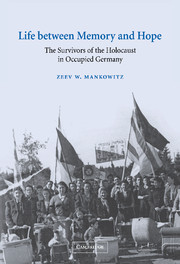Book contents
- Frontmatter
- Contents
- Plates
- Acknowledgments
- Abbreviations and note on spelling and dates
- Introduction
- 1 The occupation of Germany and the survivors: an overview
- 2 The formation of She'erith Hapleitah: November 1944 – July 1945
- 3 She'erith Hapleitah enters the international arena: July–October 1945
- 4 Hopes of Zion: September 1945 – January 1946
- 5 In search of a new politics: unity versus division
- 6 The Central Committee of the Liberated Jews in Bavaria
- 7 The politics of education
- 8 Two voices from Landsberg: Rudolf Valsonok and Samuel Gringauz
- 9 Destruction and remembrance
- 10 The survivors confront Germany
- 11 She'erith Hapleitah towards 1947
- Concluding remarks
- Bibliography
- Index
- Studies in the Social and Cultural History of Modern Warfare
6 - The Central Committee of the Liberated Jews in Bavaria
Published online by Cambridge University Press: 06 August 2009
- Frontmatter
- Contents
- Plates
- Acknowledgments
- Abbreviations and note on spelling and dates
- Introduction
- 1 The occupation of Germany and the survivors: an overview
- 2 The formation of She'erith Hapleitah: November 1944 – July 1945
- 3 She'erith Hapleitah enters the international arena: July–October 1945
- 4 Hopes of Zion: September 1945 – January 1946
- 5 In search of a new politics: unity versus division
- 6 The Central Committee of the Liberated Jews in Bavaria
- 7 The politics of education
- 8 Two voices from Landsberg: Rudolf Valsonok and Samuel Gringauz
- 9 Destruction and remembrance
- 10 The survivors confront Germany
- 11 She'erith Hapleitah towards 1947
- Concluding remarks
- Bibliography
- Index
- Studies in the Social and Cultural History of Modern Warfare
Summary
In the second half of 1945, building on the momentum generated at the St. Ottilien Conference, the Tsentral Komitet fun di Bafreite Yidn in Daytshland – the Central Committee of the Liberated Jews in Germany (Zentral Komitet in the transliteration of the time and thus ZK) -continued to expand the scope of its activities and to shape its organizational structure. This development was outwardly symbolized by the transfer of the offices of the Central Committee from Feldafing to the headquarters of UNRRA in the Deutsches Museum in Munich and from there to 3 Sieberstraße which also became home to the JDC and a central drawing point to She'erith Hapleitah as a whole. Perhaps a more substantive and telling measure of this process of expansion and growth would be to compare the first hesitant steps taken at St. Ottilien with the public notice, local and international, that attended the impressive Congress of She'erith Hapleitah at the end of January 1946.
On 8 August the Council of the Liberated Jews in Bavaria met for the first time and elected the new Central Committee which consisted of five representatives from Munich, three each from Landsberg and Feldafing with Dr. Zalman Grinberg who continued to direct the St. Ottilien hospital reelected as chairman. Dr. Samuel Gringauz, the President of the Council, and his colleagues understood that the great distances between the various parts of the occupation zones together with difficulties of travel and regular communication meant that the Central Committee would have to restrict its sphere of competence to Bavaria.
- Type
- Chapter
- Information
- Life between Memory and HopeThe Survivors of the Holocaust in Occupied Germany, pp. 101 - 130Publisher: Cambridge University PressPrint publication year: 2002

